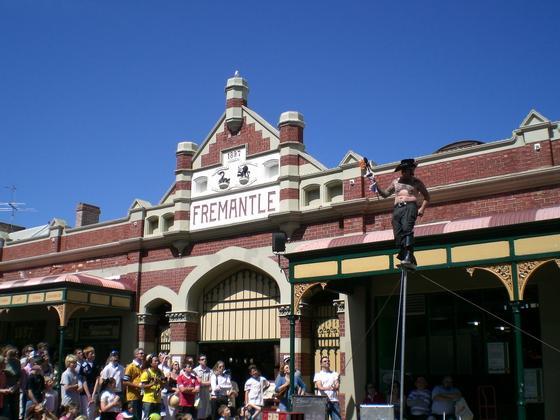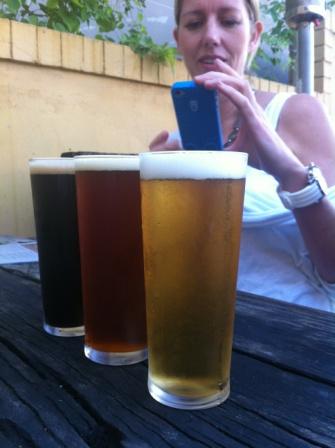
Does Freo still hold the mantle?
Does Freo still hold the ‘spiritual’ mantle?
My first trip to what came to be recognised as the ‘spiritual’ home of craft beer in Australia was back in 1990. It was in my capacity as Best Man that I was charged with providing entertainment and amber sustenance to the male portion of the wedding party. Astute readers and those with a keen grasp of history will know that the beer landscape in Fremantle in 1990 was quite different to what it is today.
There are two beers whose vastly different charms still hold court in my beer memory. I recall vividly that we drank a very lot of what the locals delightfully referred to as ‘Big Chook Piss’ – that’s Emu Lager for those who can’t paint the mental picture – and then, at the polar opposite of the beer scale, quite a bit of Dogbolter Special Reserve Strong Ale. That’s right, kids, the humble Matilda Bay Dark Lager was once a 10% strong ale with a kick like a cornered cougar.*
For those (like me at the time) weaned upon 5% lager this was something of a shock to the system. Sad, now, that I realise it would be almost 10 years before I would again taste real flavour in my beer; and that’s exactly what prompts this piece. 
Revisiting Fremantle after so long away was a bit like a pilgrimage and I was keen to see if the tag of ‘spiritual home’ of craft beer still attached worthily. Places of ‘worship’ like the Little Creatures brewery and the Sail & Anchor have probably had their haloes slip in recent years with changes in ownership structure leaving many doubting their real esoteric value. The value to the region as tourism, employment and cultural value is undisputed.
So how does ‘Freo’ today compare to the one of old and how does what I now know about beer influence my opinion? Maybe the fact that I was way out West for business made me more acutely aware of the tourist element of Fremantle and the close proximity of Notre Dame University highlighted the youthful nature of its streets and waterfront. A real art community feel also gave the town a sense of purpose and a relaxed, casual vibe.
The availability of good beer is, not surprisingly, a focus to which I will now turn. Despite the loss of the brewing facility at The Sail & Anchor, the venue itself has maintained a sense of its rich history with glass cabineted-displays showcasing the beers and the brewing philosophy which established its credentials as well as paying homage to its brewing past. The 43 taps poured everything from Moo Brew and Bridge Road to Mountain Goat (including seasonal) and local offerings from Colonial, Mash, Nail and their own ‘home brands’ alongside ‘business partner’ beers from Gage Roads. Internationals like Rogue, Anderson Valley and Yeastie Boys were also available, meaning that beer drinkers of any ‘rank’ could find something to suit with each beer presented with a small printed tasting note slip.
Sadly, though, there is just a slight feeling that the Sail & Anchor is not what it used to be. Maybe it needs to be something different and maybe it needs to keep up a more ‘mainstream’ appeal – it just feels as though its new masters don’t have the same feel for the craft that built it. It’s neither a good nor a bad thing – sometimes things just change.
A short walk (23 of my regular strides) across South Terrace beckons the airy courtyard/beer garden-welcoming Monk Brewery & Kitchen. Aside from the ambience and the ability to soak up the afternoon sun accompanied by friendly chatter and a frosty pint, The Monk offers what no-one else can – The Monk beers. Licensing restrictions mean that the fine ales and lagers being brewed with passion and skill by Paul Wyman are available only from taps at the venue. This means two things – one; the locals and Fremantle visitors are afforded a rare and rewarding treat and two; once you’ve had the beers from the source you feel somewhat deflated heading back home.
At this point I need to step back and put that old ‘average punter’ hat and look at brewery visits from the point of view of one whose visit begins with a polite greeting, ends with a hearty farewell and squeezes a few beers in between. Mine usually starts with a big ‘G’Day!’ from the brewer as he thrusts a foaming jar into my claw, moves through to the Brewhouse for more tastes straight from the bright beer tanks, continues as required in this same vein and finishes with a six-pack tucked under the arm whilst wondering who switched my regular legs for these slightly wobbly replacements.
However, I can’t help thinking that any ‘average punter’ who was to ask nicely would just as likely be offered a similar welcome by the very hospitable and very aptly-Twitter-tagged ‘six-foot-six brewer’. One advantage of having a restricted brewing license is that the right brewer will ensure that a good range of beers are available year-round and that special releases and limited batch ‘seasonals’ are there to treat the knowledgeable. I refer the jury to Exhibit ‘A’ – a Kimchi Saison that managed to combine the most magnificent farmyard funk, sweet malt with a sudden hit of fermented cabbage that snuck in mid-palate and disappeared just as quickly before heading towards a perfectly refreshing dry finish. The beer itself was matched only by Paul’s insistence that he pop into the cellar and specially tap the keg just for our four serves.
Another short walk up the road and away from the bustling tourist strip is the Norfolk Hotel, suggested through local knowledge and a very pleasant surprise. The livery, style and visible marketing might suggest a more pedestrian beer selection but don’t let the ‘chain pub’ appearance fool you – this pub does beer. Good beer. From B2 Bomber MK III to Mountain Goat Summer Ale or a hoppy offering from Squires to Feral and plenty in between from around 30 taps, the choice was a pleasant surprise. Even more surprising was the ‘hidden gem’ of the basement space featuring a wall of top shelf spirits and three more beers on tap.
To have all three of these venues – and the iconic Little Creatures brewery – within an afternoons’ stroll of the heart of the town puts it on par with sections of Melbourne’s inner suburbs, Brisbane’s Tenneriffe/Newstead/New Farm ‘precinct’ or Sydney’s Newtown or Surrey Hills for a good concentration of quality venues. But does it alter the way in which we see Freo in terms of its past and its undeniable contribution to the craft beer history in Australia?
Has ‘Freo’ kept/regained/lost its mantle? Are there still enough unique and interesting experiences relevant to new craft beer drinkers to justify ‘the crown’? Maybe. Is Freo still a worthy destination for seasoned veterans wanting to holiday without having to settle for packaged-only beery goodness? Hells yeah. Will Freo always be the place where ‘it all began’? Of course.
And so to a conclusion; good beer is where you find it and, if you can find a ‘precinct’ which has two or more great venues pouring great beer in a nice place populated by friendly staff and locals then you’re blessed and you best take full advantage. But, at the end of the day, enjoy the company you have chosen to share the experience with, revel in the conversation that only good beer allows and decide that ‘there and then’ is the spiritual home of good beer.
*Yes, even that type of cougar. I assume.
**I haven’t included a lengthy review of the Little Creatures brewery as I figure the beers available are well known enough already.




